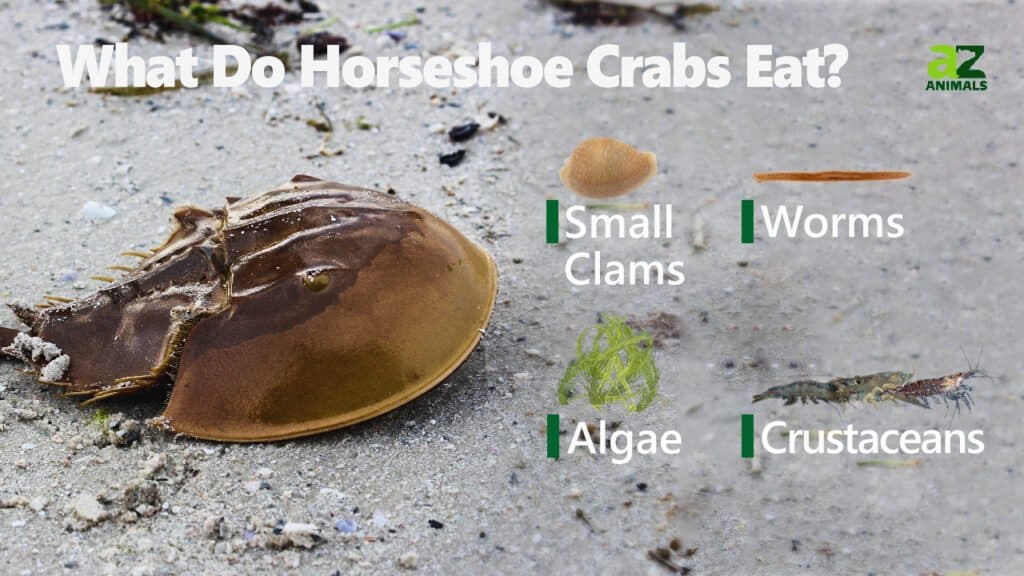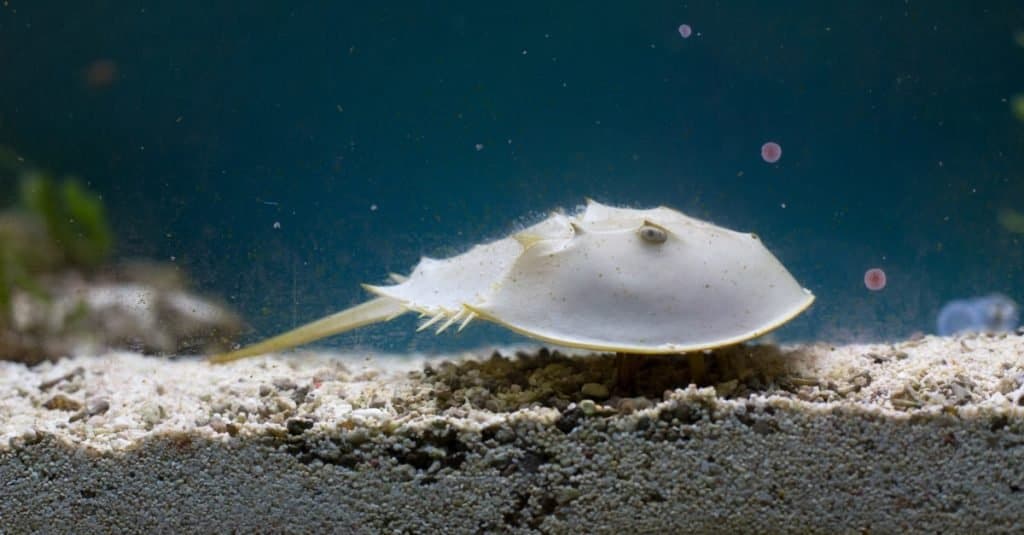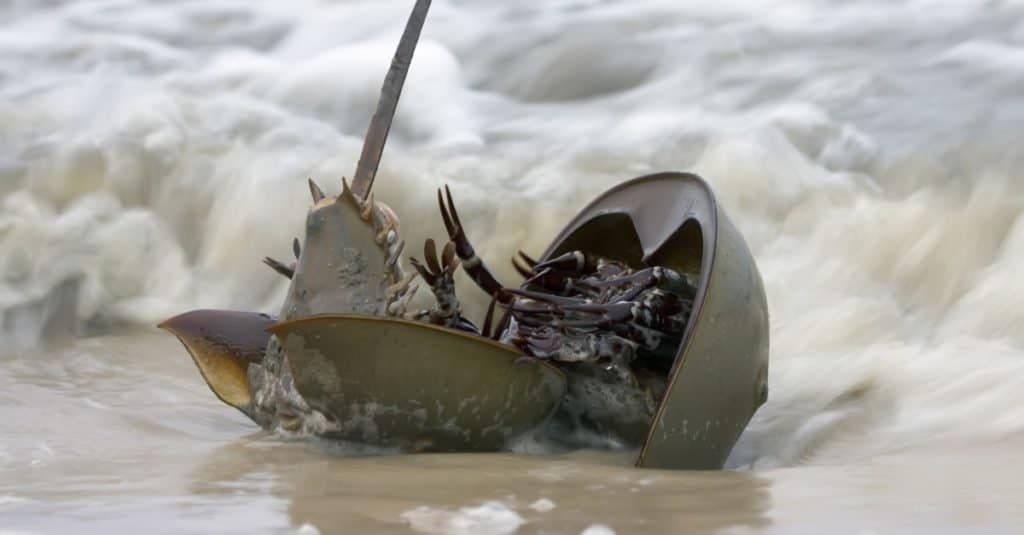Horseshoe crabs are, in fact, not even crabs! These mysterious little animals have been on earth for millions of years, and we still don’t know everything about them. Today, let’s take a look at their diets and learn what makes them special. Additionally, we are going to look at one of the strangest things that humans use horseshoe crabs for – their blood. Let’s discover: what do horseshoe crabs eat?
What do horseshoe crabs eat?

Horseshoe crabs are omnivores that mostly eat other smaller sea creatures that include worms, clams, and crustaceans. In addition, they’ll also eat plant matter such as algae.
Horseshoe crabs fill a similar environmental role as spiders do on land. Horseshoe crabs are actually not crabs, but part of the arachnid family, explaining this ecological similarity. They have been around for over 300 million years, and over all that time, their diet hasn’t changed all that much!
The primary food source for horseshoe crabs comes from smaller organisms underwater. Most of their diet is made up of worms, clams, crustaceans, and other small animals they can find. In the same way that spider kills and eats smaller insects in their environment, horseshoe crabs act in the same way, only without poison or venom.
During the night, worms and clams come out to feed, prompting the horseshoe crab to act. During the evening hours, they scurry along the seafloor, looking for morsels and other small animals that they can crush up and eat. Additionally, they are believed to occasionally eat algae when the situation demands it.
A complete list of foods that horseshoe crabs eat
Here is a complete list of foods that horseshoe crabs eat:
- worms
- clams
- small crabs
- crustaceans
- algae
- any small animal
How do horseshoe crabs get their food?

Horseshoe crabs use their strong legs to crush food before passing it into their gizzard, and later their stomach.
©Budimir Jevtic/Shutterstock.com
Horseshoe crabs don’t have many predatory advantages like teeth or venom; instead, relying on other methods to get their prey. They generally hunt and night and sweep the seafloor and coastal edges, looking for any slow-moving or stationary prey, things like clams or worms. Since they don’t have teeth, whatever they find needs to be smaller than they are.
Once a horseshoe crab finds prey, it will grasp it with strong legs and begin breaking it apart. The goal is to crush the food up so they can pass it into their mouths in small pieces. The only exception to this method of eating is algae since it’s soft enough to be eaten without being crushed up. This method of eating is similar to chewing food, only externally.
A secondary method that horseshoe crabs use to process their food is through a primitive version of a gizzard. It’s similar to that of a bird and contains small hard things that the food then passes through. Like a grinder, the gizzard helps to further process the food before it passes into the stomach. For shelled prey, this is an essential step of digestion.
Where do horseshoe crabs live?
There are four species of horseshoe crabs, three of which live in Asia and one that lives in North American waters. The North American species can be found all along the Atlantic coast, from the Delaware Bay all the way south through the Gulf of Mexico. Beachgoers on the Atlantic are likely to see horseshoe crabs as they search at the tiebreak near dusk or dawn, looking for food.
The other three species of horseshoe crab live in Southeast Asia. These species live in tidal and brackish waters, especially the mangrove horseshoe crab, a species that evolved to live in the brackish waters of mangrove regions.
What animals compete with the horseshoe crab?

Horseshoe crabs are threatened by human overfishing for bait and pharmaceutical use.
©Boris Z./Shutterstock.com
Horseshoe crabs have a few natural predators, as well as some species that don’t prey on them but compete with them for resources. Generally, the main competition for horseshoe crabs is crustaceans that have the same diet as they do. Since their main food sources, worms and small crustaceans, are at the bottom of the food chain, they are in completion with nearly any predator who feeds on the same thing. Thankfully, the ocean is a plentiful place, and the competition isn’t as fierce as it would be for other land animals in the same ecological niche.
When it comes to predators, however, the horseshoe has a few. The most vulnerable time for horseshoe crabs is when they are born as eggs. Without their protective shells, they are likely to be eaten by fish or other marine animals. When they do hatch, they are larvae but still open to attack from almost everything in the ocean. When they finally grow (through multiple shedding and molting cycles), they have a hard outer shell that protects them from most predators. During this stage, their only real predators are sharks, seagulls (when found overturned on the beach), and sea turtles.
The eggs of the horseshoe crab are an essential element to many species’ diets around the world, and with potentially declining numbers of crabs, other species populations are threatened. One example is the red knot, a migratory bird that relies on its eggs as they travel 9,000 each migratory cycle. With reduced crab numbers, the red knot is threatened.
Why is horseshoe crab blood important?
Horseshoe crabs provide an interesting medical substance through their blood. Their blood contains important immune cells that are used to detect certain antibodies, allowing humans to test for certain diseases. Essentially, the bright blue blood of a horseshoe crab is used in the creation and testing of vaccines all over the world.
Biomedical groups harvest the crabs, bleed them for around 20-30% of their blood content, and then release them 2-3 days later. There have been some reports that the collectors are just selling the crabs for bait instead of releasing them, further threatening populations.
The photo featured at the top of this post is © Shura007 / Public domain, from Wikimedia Commons, the free media repository – License / Original
Thank you for reading! Have some feedback for us? Contact the AZ Animals editorial team.






